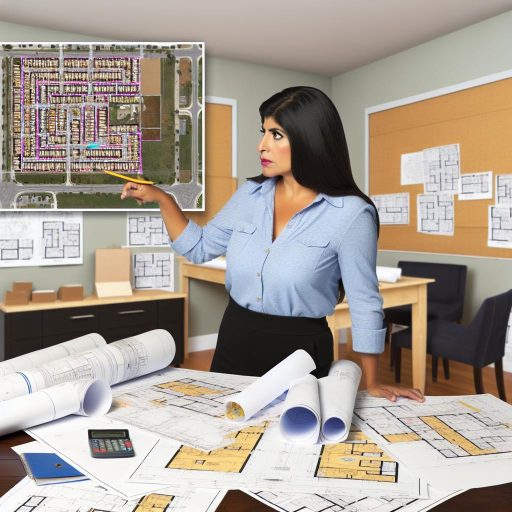Analyzing Economic Indicators: Job Growth and Income Trends
Understanding Job Growth
Job growth is a crucial indicator of a neighborhood’s economic health.
Rising employment opportunities attract new residents and businesses.
Consequently, examine local job market trends to gauge potential growth.
Look at job postings in various sectors to assess demand.
Furthermore, research large employers in the area, as they drive economic activity.
Income Trends in Neighborhoods
Income trends reveal the financial stability of a population.
Increasing median household income indicates a healthy economy.
Moreover, compare income levels across neighborhoods for a broader perspective.
High income can lead to increased consumer spending, benefiting local businesses.
Analyzing Statistical Reports
Utilize statistical reports for a comprehensive understanding of job and income trends.
Sources like the Bureau of Labor Statistics offer valuable data.
Additionally, local chamber of commerce reports can shed light on economic shifts.
These insights allow investors to make informed decisions based on quantifiable metrics.
Identifying Growth Industries
Recognizing key industries driving job growth aids in neighborhood assessment.
Focus on sectors like technology, healthcare, and renewable energy.
These industries often expand rapidly, creating numerous job opportunities.
Investors should target areas where these industries are expanding.
Monitoring Real Estate Development
Real estate development often reflects the economic vitality of a neighborhood.
New residential and commercial projects indicate investor confidence.
Pay attention to government initiatives encouraging development.
Such projects commonly lead to job creation and rising property values.
Community Engagement and Quality of Life
Community engagement is vital for sustainable neighborhood growth.
A strong sense of community attracts new residents and keeps them engaged.
Additionally, assess the quality of life indicators, such as crime rates and education.
High-quality schools and low crime rates enhance neighborhood appeal.
Evaluating Infrastructure Developments
Transportation Enhancements
Transportation improvements signify a neighborhood’s growth potential.
Look for new roads, bridges, and public transit options.
These upgrades often attract new businesses and residents.
Consequently, property values may increase over time.
Consider areas with planned transportation expansions.
For example, the introduction of light rail can stimulate local economies.
Public Service Developments
Public services play a crucial role in neighborhood desirability.
Evaluate new schools, parks, and community centers in the area.
These developments enhance the quality of life for residents.
High-quality schools can attract families and boost demand for housing.
Parks and recreational facilities provide important social engagement spaces.
Access to Healthcare Facilities
Access to healthcare is a major draw for potential residents.
Look for new hospitals or clinics being built nearby.
Quality healthcare access indicates a commitment to community well-being.
This factor can significantly influence real estate values.
Technological Infrastructure
Modern neighborhoods often incorporate advanced technological infrastructure.
High-speed internet and smart city systems enhance living standards.
Research areas where tech companies are investing in infrastructure.
These investments usually signal long-term growth potential.
Subsequently, such neighborhoods may attract a tech-savvy population.
Job Opportunities and Economic Development
Infrastructure improvements can lead to increased job opportunities.
Check for new businesses or economic development initiatives in the area.
A thriving job market often correlates with rising property values.
This association makes the neighborhood a favorable investment target.
Assessing Neighborhood Amenities
Understanding the Importance of Amenities
Amenities greatly influence real estate value.
Proximity to schools, parks, and retail spaces attracts buyers.
Consideration of these factors yields informed investment decisions.
Evaluating Schools
The quality of local schools significantly impacts neighborhood desirability.
High-ranking schools often lead to increased home values.
Research school ratings and performance metrics thoroughly.
Engage in community forums to gather parent reviews.
Explore opportunities for new schools in developing areas.
Exploring Parks and Green Spaces
Nearby parks and recreational areas enhance livability.
Families and young professionals often seek neighborhoods with green spaces.
Evaluate park size, facilities, and maintenance quality.
Accessibility to recreational areas can be a strong selling point.
Assessing Retail and Commercial Options
Convenience in shopping and dining enhances a neighborhood’s appeal.
Examine the variety and quality of local retail establishments.
Look for upcoming developments that may expand commercial spaces.
Proximity to grocery stores and restaurants is crucial.
Identifying Future Developments
Researching proposed developments can reveal potential growth areas.
Stay informed about city planning meetings and zoning changes.
Connect with local real estate agents for insider knowledge.
Emerging neighborhoods often see increased demand after new amenities open.
Explore Further: Step-By-Step Guide To Building Wealth Through Rental Property Investment
Conducting Demographic Research
Population Growth Trends
Population growth serves as a key indicator of emerging neighborhoods.
Analyze trends in population increase over the past decade.
Look for areas with a consistent rise in residents.
Additionally, compare growth rates with surrounding neighborhoods.
Identify regions attracting younger demographics, such as millennials and families.
Monitor city reports and census data for accurate insights.
Diversity and Its Benefits
Diversity contributes to a vibrant community atmosphere.
Assess the range of ethnicities and cultures present in the area.
Communities with diverse populations often experience economic growth.
Explore local events and cultural festivals as indicators of diversity.
Engagement in community activities fosters a sense of belonging.
As a result, real estate values may increase with growing community engagement.
Housing Demand and Affordability
Evaluating housing demand is crucial in demographic research.
Identify whether there is a shortage of affordable housing options.
Check rental rates to gauge demand in specific neighborhoods.
High demand can signal an opportunity for real estate investment.
Moreover, consider the balance between supply and demand.
Data from local housing authorities can provide valuable insights.
Access to Amenities
Research the availability of amenities in potential investment areas.
Look for parks, schools, and transportation options nearby.
Access to quality amenities often correlates with population growth.
Neighborhoods that appeal to families tend to attract more residents.
Evaluate upcoming developments and improvements in the area.
This progress can enhance the desirability of the neighborhood.
Find Out More: Understanding Market Trends For Successful House Flipping Investments
Monitoring Real Estate Trends
Property Value Changes
Tracking property value changes is essential for smart investments.
Consider neighborhoods with consistent appreciation.
Rising home prices often indicate a growing community.
Conversely, stagnant prices might suggest an oversaturated market.
Utilize online platforms to monitor property values regularly.
Tools like Zillow and Redfin provide valuable insights.
Consult local appraisers for expert opinions on value fluctuations.
Stay updated on new developments that can influence property values.
Analyzing Sales Data
Sales data is a crucial aspect of identifying emerging neighborhoods.
Look for trends in home sales over the past few years.
Increasing sales volume often points to neighborhood popularity.
Pay attention to the average days on market for properties.
Homes selling quickly might indicate high demand.
Examine the list-to-sale price ratios for insights into competition.
High ratios suggest buyers are competing for available properties.
In addition, review the profiles of recent buyers in the area.
First-time buyers often contribute to revitalizing neighborhoods.
Seeking Community Development Initiatives
Community development initiatives can signal promising neighborhoods.
New parks, schools, and restaurants enhance local appeal.
Check for any upcoming infrastructure projects planned in the area.
Improved transportation can attract new residents and businesses.
Local government websites provide updates on these initiatives.
Attend community meetings to gain insight into future plans.
Engagement in community improvement often fosters a sense of belonging.
Look out for grants and funding available for local enhancements.
Consulting Real Estate Professionals
Real estate agents hold valuable information about local trends.
Partnering with a knowledgeable agent can enhance your strategy.
They can guide you through market fluctuations effectively.
Attend local real estate networking events for more insights.
Connecting with industry professionals broadens your understanding.
Consider discussing your investment goals to gain tailored advice.
Brokers often possess unique knowledge of neighborhood dynamics.
See Related Content: How To Diversify Your Investment Portfolio With Rental Properties

Identifying Local Government Initiatives
Zoning Laws
Zoning laws play a crucial role in shaping neighborhoods.
These regulations determine land use and affect property values.
Research the current zoning classifications in targeted areas.
Local governments often update these laws to encourage development.
Changes in zoning can signal potential for property appreciation.
Revitalization Projects
Keep an eye on local revitalization initiatives.
These projects aim to improve infrastructure and community resources.
City councils frequently announce these efforts at public meetings.
Community engagement often indicates strong support for revitalization.
Development grants can further enhance investment potential.
Collaboration with Developers
Local developers often have insight into upcoming projects.
Establishing relationships can provide exclusive information.
Participate in networking events to meet local industry professionals.
These connections may lead to early investment opportunities.
Impact of Transportation Improvements
Transportation access significantly influences neighborhood growth.
New rail lines or bus routes usually enhance property appeal.
Monitor transportation authority announcements for upcoming projects.
Areas near transit developments typically see increased demand.
Community Resources and Amenities
Strong community resources attract new residents.
Look for neighborhoods investing in parks and recreational facilities.
Schools with high ratings enhance property values significantly.
Access to grocery stores and healthcare facilities is crucial.
These amenities contribute to the overall desirability of a neighborhood.
Uncover the Details: How to Assess Market Trends for Strategic Property Purchases
Exploring Crime Rates and Safety Perception in the Neighborhood
Understanding Crime Statistics
Crime statistics serve as a key indicator of neighborhood safety.
Analyzing these figures helps investors gauge community well-being.
Start by reviewing local police department reports.
They often publish annual crime reports and trends.
Websites like NeighborhoodScout and CrimeReports provide detailed insights.
Assessing Trends Over Time
Crime rates can shift over time, offering valuable perspectives.
Look for neighborhoods with declining crime rates.
This trend often signals revitalization and increased safety.
Check historical data to identify consistent patterns.
It’s essential to compare these trends with surrounding areas.
Understanding Safety Perceptions
Safety perception is subjective but highly influential.
Engage with locals to gather their insights on neighborhood safety.
Social media platforms can also reveal community sentiment.
Look for community forums discussing safety issues.
These discussions can highlight specific areas of concern.
Utilizing Community Resources
Connect with local neighborhood watch groups for firsthand information.
These groups often address safety initiatives and improvements.
Additionally, community meetings can provide valuable updates.
Attend such meetings to stay informed on local issues.
Local schools and businesses often share safety concerns too.
Factors Beyond Crime Rates
Consider factors like foot traffic and neighborhood activity.
Busy neighborhoods tend to feel safer due to increased visibility.
Look for community events that encourage engagement.
A vibrant neighborhood often signals a commitment to safety.
Examine the quality of local amenities, like well-lit parks.
Importance of Research on Safety
Your research on crime rates and safety perceptions is essential.
Gathering this information leads to informed investment decisions.
Investing in neighborhoods with improving safety is a wise strategy.
Lastly, always assess how safety perceptions match the data.
This comprehensive understanding will guide your real estate choices.
Networking with Local Real Estate Agents and Community Organizations
Building Relationships with Local Agents
Establish connections with local real estate agents in your target neighborhood.
These professionals possess valuable knowledge about emerging trends.
Attend open houses to meet agents and learn about the market.
Engage with agents during networking events or community meet-ups.
Consider joining local real estate clubs to expand your network.
Understanding Market Trends through Agents
Real estate agents can provide insights into market dynamics.
They often know which neighborhoods are on the rise.
Ask agents about recent sales data and price trends.
This information can guide your investment decisions effectively.
Collaborating with Community Organizations
Identify community organizations that focus on local development.
Engaging with these groups can help you understand community needs.
Attend meetings hosted by neighborhood associations.
These events are great for networking and gathering information.
Consider volunteering for local events to build connections.
Leveraging Social Media and Online Platforms
Utilize social media to follow local agents and organizations.
Join online forums that discuss real estate topics in your area.
Engage with community posts to gather real-time insights.
Use LinkedIn to connect with professionals in the real estate sector.
Participating in Local Initiatives
Involvement in local initiatives can enhance your visibility.
Attend town hall meetings to voice your interest in real estate.
Engage in discussions about neighborhood improvements and developments.
This participation helps build rapport with community leaders.
Establishing Trust and Credibility
Building trust takes time and consistent effort with local agents.
Demonstrate your commitment by following through on discussions.
Share your investment goals to align with local expertise.
Consider utilizing agents as partners in your investment journey.
Additional Resources
JLL: Commercial real estate | Property investment
Vacant and Abandoned Properties: Turning Liabilities Into Assets …




